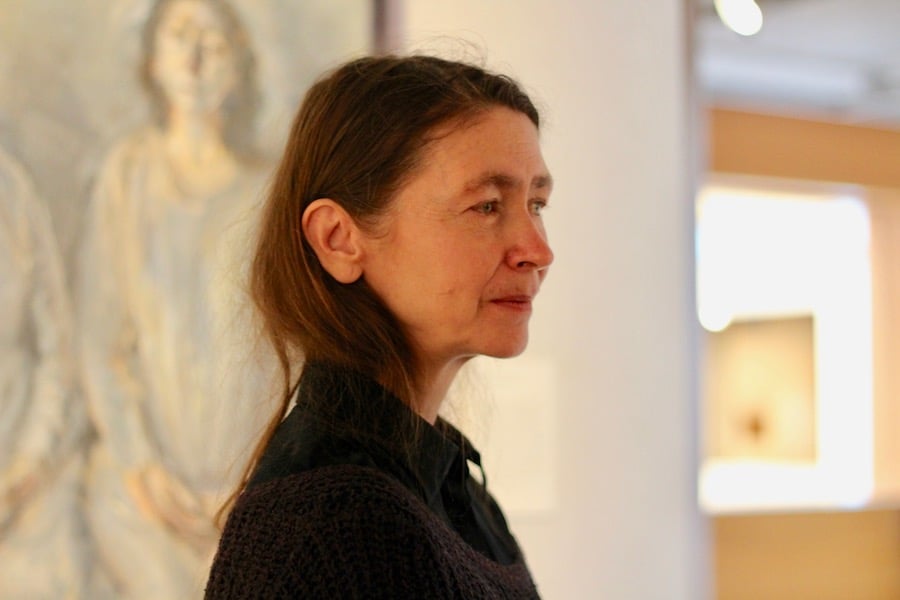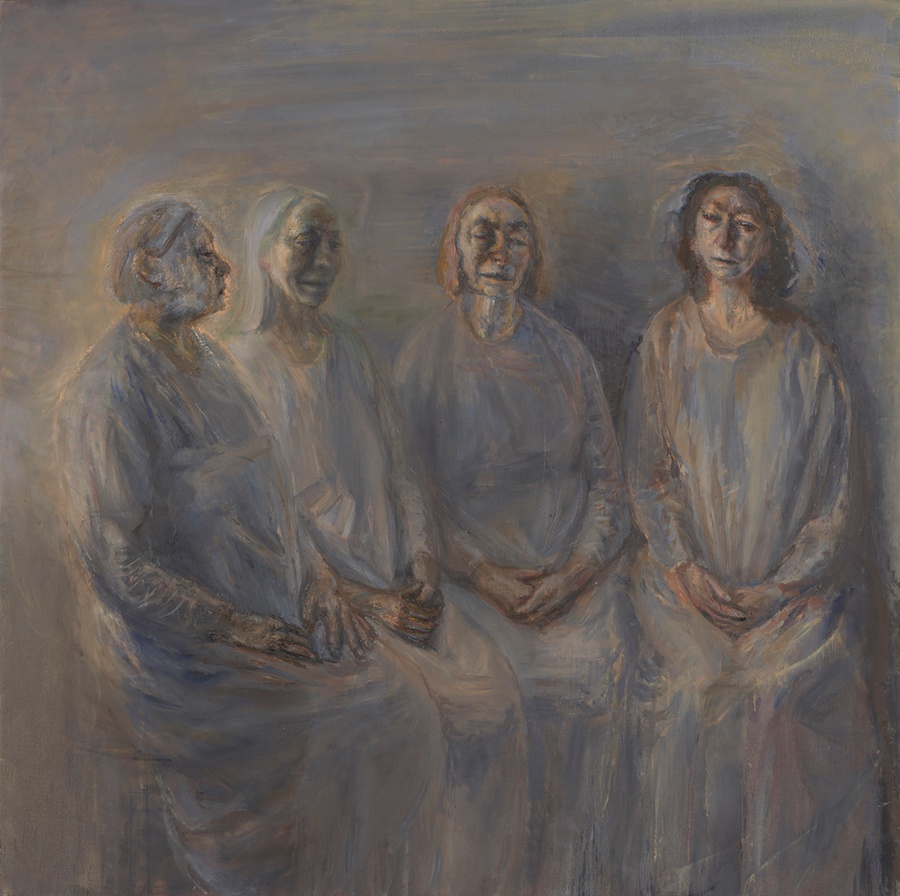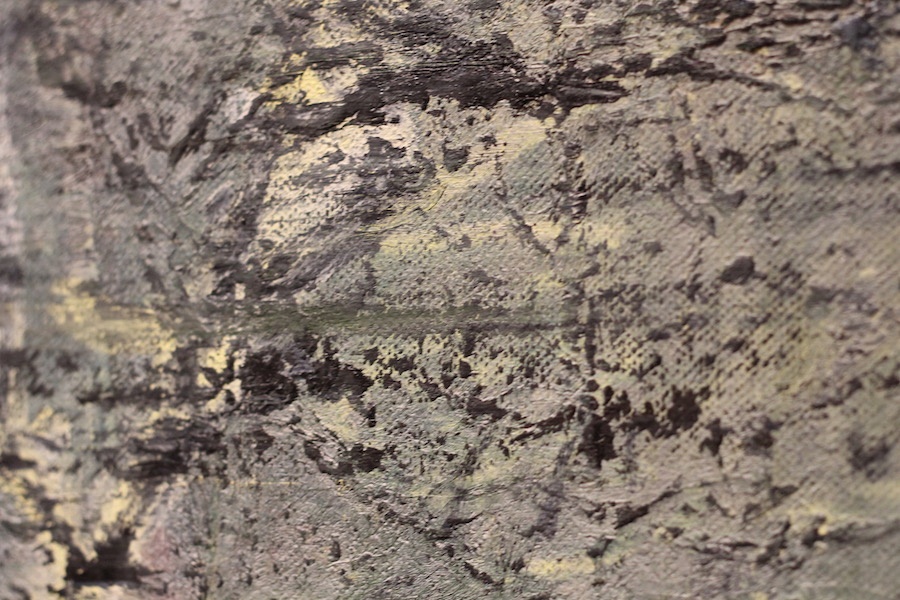
“I think I’m with Virginia Woolf,” Paul said as the show opened last month. “I think women do have a different sensibility, and I think they need to be aware of that in their work.” Lucy Gellman Photo.
In Celia Paul’s Self-Portrait, the eyes get you first. They have willed themselves open but are elsewhere, ringed with red and orange that spreads to the forehead, cheeks, nose. Her face shrinks around them: sinuses the color of a ripe bruise, hair piled and hanging, hunched, rounded shoulders. It’s an arresting exhaustion, like she has been weeping and working interchangeably, and will for the rest of her waking days.
That graceful, endless sense of emotional labor is at the very center of Celia Paul, an intimate and striking exhibition of the artist’s work at the Yale Center for British Art (YCBA), curated by critic Hilton Als and up now through Aug. 12. It opened last month with a lecture from Als, for which Paul was in attendance.
Nestled on the second and fourth floors of the center, it marks the first of three exhibitions that Als is curating there between now and fall 2020. The other two, scheduled for fall of 2019 and 2020 respectively, will feature artists Lynette Yiadom-Boakye and Njideka Akunyili Crosby. The three shows will end with Als’ publication of a volume on the three artists, all of whom are working through diasporic contexts.
The exhibition is an outgrowth of Als’ preoccupation and ultimate friendship with Paul, which began some 14 years ago on a visit with the theater critic John Lahr. As the two sat in Lahr’s London home, Als’ eye caught a small painting of Paul’s, its mere presence stopping the conversation.
He was, he later wrote for the New Yorker, “taken by the voluptuous sadness of the small face in the dense little portrait (I did not know the subject), so deep and painterly that I knew I was in the presence of an artist like no other.”
That same feeling—a painting’s ability to catch you mid-thought, and stop your breath entirely—is true of My Sisters in Mourning (2015-16), the first work to emerge as viewers enter the exhibition bay. Hung squarely on the show’s first wall, the painting depicts Paul’s sisters Mandy, Lucy, Jane and Kate from left to right, seated in the milky, gray-blue light of her London studio.
Paul is absent from the grouping, but her grief is everywhere, and dense enough you can almost puncture it. There’s a dark drop cloth of a background, wisps of blue-and-yellow light that punctuate the work, and paint that is aggressive but not tempestuous—piled on, then piled on again, but with a certain and immense care. In the space before her sisters, there’s the unshakable feeling that someone else should be there. Not Paul exactly (she has said she would be second from the right if she were in the painting) but the life force that kept them together.

Celia Paul, My Sisters in Mourning , 2015-16. Image courtesy Yale Center for British Art.
In the painting’s world—which cannot not bleed into ours—it is 2015, and Paul’s mother has just died at the age of 87 (“and I think that’s far too soon,” Paul said at a press event in April). Even without context, it is clear she was a giant of a woman, with a quiet and steady hand that led her girls forward.
Grief hangs heavy in the room: the four sisters have all donned boxy, oversized white dresses, and look near-ready to join their mother in the longest, eternal sleep. Their backs and shoulders struggle not to sag, hands clasp in their laps. From each of them you can almost hear a sort of restrained, open-lipped gasp.
There’s an attempt to keep it together, triumphed by the utter exhaustion of loss. At the left, Mandy is straight-backed and regal, casting her gaze over the three women. The light around her face is gem-like and razor-sharp, a sort of holy envelope as it extends around her body. Her hands, weathered but not gnarled, sit squarely on her thighs.
If she is at peace—or perhaps made of as much steel as her mother—the younger sisters are not there yet. With almost identically clasped hands, they let their eyes wander, their bodies hunched forward. Lucy casts her face downward, eyes half-open and hard to see. Jane looks as if she may wobble and fall from her chair from exhaustion. Kate tilts her head almost imperceptibly to our right, as if she is listening for a whisper. Her eyes are swollen slits. Her lips, two thin ribbons, hang open just slightly.
But in Paul’s nimble hands, that grief—the act of mourning this woman—is divine. The painting’s use of light, coming in from our left and swirling around in wisps on the canvas, says that much almost immediately. It’s something other-worldly, bridging the realm her sisters are in and the one her mother now occupies.

A detail from My Sisters in Mourning. Lucy Gellman Photo.
It’s a kind of religious homage that feels new to her oeuvre. In her much earlier Family Group (1984-86, and not featured in the exhibition), the sisters mourn their father in brighter color and wobbling, thickly painted shapes, surrounding their mother on a bed that seems off-kilter. There is tremendous loss there, no question. But there’s not the same sense of being utterly tired—and of knowing that the hardest task may be getting up and greeting the day all over again.
And so My Sisters in Mourning becomes an anchor, establishing Celia Paul as a show about the arduous, sublime, unending task of being a woman—and particularly being this woman, from this family. Yes—viewers would do well to resist the urge to essentialize, because the work is not without immense, masterful skill, and it does not stop at Paul’s gender or her background.
Rather, it is extremely frank, and pays homage to those who have come before. Just diagonal to My Sisters in Mourning in the same gallery is her 2017 The Bronte Parsonage (with Charlotte's Pine and Emily's Path to the Moors), a painting made magnetic by its use of tiered, bright shafts of light from a break in the clouds, and a towering pine that feels other-worldly. Or quiet, contemplative seascapes, where one feels like Paul Is finding the right moment to jump into the waves, or float on their momentum alone.
“I think I’m with Virginia Woolf,” Paul said as the show opened last month. “I think women do have a different sensibility, and I think they need to be aware of that in their work.”
That narrative thread continues upstairs, where Als has curated a display of Paul’s influences in the YCBA’s Long Gallery. Among a small piece by her teacher and former lover Lucian Freud and a cocky, baby-faced self-portrait by a young Sir Joshua Reynolds are six paintings by the artist Gwen John, who spent much of her life eclipsed by her brother Agustus and the larger-than-life sculptor August Rodin (recognition came largely after her death in 1936).
Winking out from the walls, John's figures follow you the same way that initial, arresting self-portrait does. Not to say, I understand all you’ve been through. But to say Look! I'm here. I've arrived. Have you?
Celia Paul runs at the Yale Center for British Art through Aug. 12, 2018. The exhibition is free and open to the public. For hours and more information, visit the Yale Center for British Art's website.